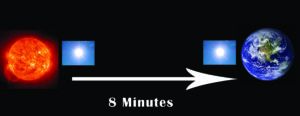The further we look into space, the further back in time we see.
This simple statement is very counterintuitive for a human being living in a local region of space-time. We experience space and time as distinct elements, but with the vast distances between light-emitting objects in space, and a finite speed of light, we end up with a coupling of space and time.
To simplify the concept a bit, imagine you and a friend are on opposite sides of the world. Your friend snaps a selfie and sends it to you at the speed of light. Since light travels incredibly fast, the photo will get to you almost instantaneously. You see the photo they just took, and effectively you get to see what they look like at that moment.

Now let’s imagine they are standing on Pluto. They take the same selfie and send it to you at the speed of light. However, Pluto is much further away, and a beam of light takes 5.3 hours to travel from your friend on Pluto to you on Earth. When the photo arrives, it is now 5.3 hours old. Your friend who sent the photo had 5.3 hours to do other things while the photo was heading to you. It’s still a relatively recent photo, and would be an accurate representation of what your friend currently looked like.
Now let’s kick it up a notch. Let’s send your friend to the closest star, Proxima Centauri, about 4 light years away. If they take a selfie and send it to you, it takes four long years for the photo to travel to you on Earth. While it’s travelling, your friend will have lived another 4 years of their life, and they will probably look very different than the picture does when it reaches you four years later. But that is the fastest that you can send the photo, there is no way to send any information faster than the speed of light, and so no matter when you receive a selfie from your friend, it is always four years old. The further away they are, the further back in time you see them.
It’s the same with astronomical objects, but there are some extreme cases. Take the Andromeda Galaxy as an example. It is 2.5 million light years away, meaning light takes 2.5 million years to reach us after being emitted by the stars of the galaxy. So when we look at Andromeda through a telescope, we are seeing it as it looked 2.5 million years ago!
With this principle, we can look further back in time by looking deeper into outer space. In fact, we can look so far back that we see the light emitted from the very first galaxies just as they were forming, when the universe was only 400 Million years old. Recently, astronomers discovered the most distant galaxy in the universe, making it one of the first galaxies to ever form.

In the above image, the galaxy looks red, due to the stretching of the light waves from the expansion of the universe. In fact, these first stars were likely a very bright blue, and several hundred times as massive as our Sun. Their incredible brightness and radiation helped to spark what is known as the ‘re-ionization epoch.’ This is the period where the entire universe was full of cold Hydrogen gas that was slowly being ionized by ultraviolet light from the first stars.
By understanding these very first stars and galaxies we can constrain the properties of the early universe and learn about how the universe grew from a small, cold clump of molecular Hydrogen into the clusters of galaxies we see today. The point is to understand the evolution of the universe that led to galaxies forming, stars forming, our Sun forming, the Earth forming, and life developing.

